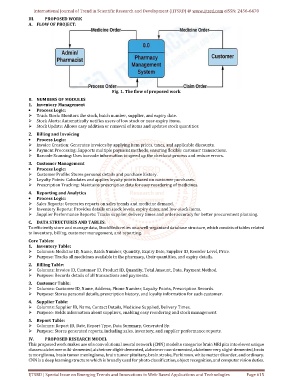Page 625 - Emerging Trends and Innovations in Web-Based Applications and Technologies
P. 625
International Journal of Trend in Scientific Research and Development (IJTSRD) @ www.ijtsrd.com eISSN: 2456-6470
III. PROPOSED WORK
A. FLOW OF PROJECT:
Fig. 1. The flow of proposed work
B. NUMBERS OF MODULES
1. Inventory Management
· Process Logic:
Track Stock: Monitors the stock, batch number, supplier, and expiry date.
Stock Alerts: Automatically notifies users of low stock or near-expiry items.
Stock Update: Allows easy addition or removal of items and updates stock quantities.
2. Billing and Invoicing
· Process Logic:
Invoice Creation: Generates invoices by applying item prices, taxes, and applicable discounts.
Payment Processing: Supports multiple payment methods, ensuring flexible customer transactions.
Barcode Scanning: Uses barcode information to speed up the checkout process and reduce errors.
3. Customer Management
· Process Logic:
Customer Profile: Stores personal details and purchase history.
Loyalty Points: Calculates and applies loyalty points based on customer purchases.
Prescription Tracking: Maintains prescription data for easy reordering of medicines.
4. Reporting and Analytics
· Process Logic:
Sales Reports: Generates reports on sales trends and medicine demand.
Inventory Reports: Provides details on stock levels, expiry dates, and low-stock items.
Supplier Performance Reports: Tracks supplier delivery times and order accuracy for better procurement planning.
C. DATA STRUCTURES AND TABLES:
To efficiently store and manage data, StockMeds relies on a well-organized database structure, which consists of tables related
to inventory, billing, customer management, and reporting.
Core Tables:
1. Inventory Table:
Columns: Medicine ID, Name, Batch Number, Quantity, Expiry Date, Supplier ID, Reorder Level, Price.
Purpose: Tracks all medicines available in the pharmacy, their quantities, and expiry details.
2. Billing Table:
Columns: Invoice ID, Customer ID, Product ID, Quantity, Total Amount, Date, Payment Method.
Purpose: Records details of all transactions and payments.
3. Customer Table:
Columns: Customer ID, Name, Address, Phone Number, Loyalty Points, Prescription Records.
Purpose: Stores personal details, prescription history, and loyalty information for each customer.
4. Supplier Table:
Columns: Supplier ID, Name, Contact Details, Medicine Supplied, Delivery Times.
Purpose: Holds information about suppliers, enabling easy reordering and stock management.
5. Report Table:
Columns: Report ID, Date, Report Type, Data Summary, Generated By.
Purpose: Stores generated reports, including sales, inventory, and supplier performance reports.
IV. PROPOSED RESEARCH MODEL
This proposed work makes use of a convolutional neural network (CNN) model to categorise brain MRI pics into eleven unique
classes: alzheimer mild-demented, alzheimer slight-demented, alzheimer non-demented, alzheimer very slight-demented, brain
tumor glioma, brain tumor meningioma, brain tumor pituitary, brain stroke, Parkinson, white matter disorder, and ordinary.
CNN is a deep learning structure which is broadly used for photo classification, object recognition, and computer vision duties.
IJTSRD | Special Issue on Emerging Trends and Innovations in Web-Based Applications and Technologies Page 615

